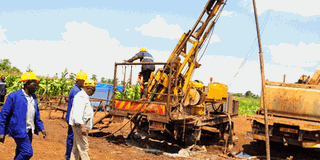Mineral traces discovered in Bunyoro

Ministry of Energy Permanent Secretary Fred Kabagambe Kaliisa (in jacket) on a fact-finding mission at Karuma Hill Exploration Area in Kiryandongo District last week. PHOTO by Stephen Wandera
What you need to know:
Redundant. The survey shows the country has mineral resources that need to be exploited.
Kampala.
Traces of Iron, copper and nickel have been seen in Kiryandongo District, according to Pearl Uganda, the company that has been licensed to prospect the area for mineral deposits.
When contacted on Saturday, state minister for Minerals Peter Lokeris, confirmed the development, saying in addition to the discoveries cited above, other rare elements, which are due for testing, were also traced.
“This happened last week. The samples, which also include Sulfates, have been taken for testing to determine whether we have them in quantities that are commercially viable,” Mr Lokeris told the Daily Monitor.
According to Mr Ghislain Furaha, the Pearl Uganda lead geologist, the mineral traces were discovered after drilling of Karuma hill, just adjacent to Bweyale in Kiryandongo District.
Quoted in a press statement issued last week, Mr Furaha, said: “Thick traces of the minerals have been encountered severally. There are encouraging signs of discovering world-class deposits. We look forward to further testing of this very prospective, potentially thick, high-grade Nickel-copper-iron zone we have seen so far.”
He continued: “We need more time and resources to follow-up with the good results by drilling additional wells to understand the deposits and reserves.”
The discovery of the mineral traces comes after an earlier aerial geo-physical survey, which identified Bunyoro region as one of the areas with high mineral potential, making it a target for mineral exploration experiments.
The 2004 survey, which covered at least 80 per cent of the country, funded by African Development Bank, the World Bank, the Nordic Development and the government of Uganda to a tune of of $43million (about shs113billion), showed that Uganda contained diverse mineral resources, waiting to be discovered and commercially exploited.
According to Mr Fred Kabagambe-Kaliisa, the Permanent Secretary of the ministry of Energy, because of the findings of the survey, the mineral sector has become attractive to investors.
what the minerals are used for
Iron, copper and nickel are important raw materials used in the production of valuable products.
Nickel is used to manufacture some types of coins and batteries.
It is also alloyed with other metals to improve their strength and resistance to corrosion.
It can also be blended with steel to make armour plate, vaults and machine parts. Copper is used as a conductor of heat and electricity; it can also be used as a building material, and a constituent of various metal alloys/blends.
Copper cylinders are used to store spent nuclear fuel. A copper cylinder with 10 cm thick walls will last for one million years before oxidising through.
Iron is commonly used in manufacturing machine tools, automobiles, hulls of large ships, machine parts, and prominently in building/construction industry.
It is also used in many different tools, surgical equipments, and appliances. Stainless steel, created when iron is combined with other metals, is a common type of steel used in a host of different products.




